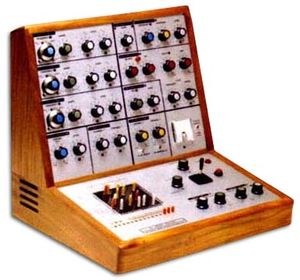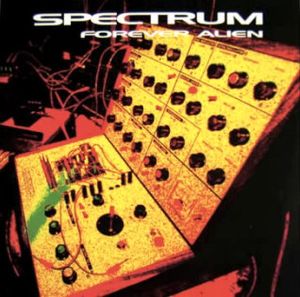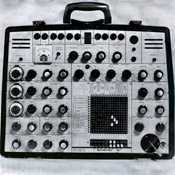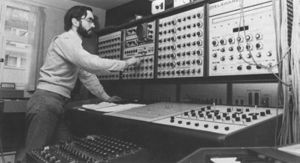Difference between revisions of "VCS3"
Martinwguy (talk | contribs) (→Pieces using VCS3 sounds) |
Martinwguy (talk | contribs) |
||
| (3 intermediate revisions by the same user not shown) | |||
| Line 1: | Line 1: | ||
{{Thumb|VCS3 Mark 1}} | {{Thumb|VCS3 Mark 1}} | ||
| + | {{Thumb|Forever Alien album cover|A VCS3 on the cover of Pete Kember's album ''Forever Alien''}} | ||
{{Thumb|EMS LP 1 cover|VCS3 Synthi}} | {{Thumb|EMS LP 1 cover|VCS3 Synthi}} | ||
{{Thumb|Richard Yeoman-Clark programming the Delaware|EMS Synthi 100}} | {{Thumb|Richard Yeoman-Clark programming the Delaware|EMS Synthi 100}} | ||
The [[VCS3]] is an analogue synthesizer which Delia used at [[Unit Delta Plus]] and eventually also at the [[BBC Radiophonic Workshop]]. | The [[VCS3]] is an analogue synthesizer which Delia used at [[Unit Delta Plus]] and eventually also at the [[BBC Radiophonic Workshop]]. | ||
| + | |||
| + | <BLOCKQUOTE> | ||
| + | It wasn’t until 1965 that the Workshop bought its first synthesiser from Electronic Musical Instruments (London) Limited, more commonly known as EMS. This was the VCS3, an unassuming little machine consisting of a box with two sloping panels and a plug-in keyboard. Another version, the Synthi A or Suitcase, was similar to the VCS3, but as its name implies, it was built into a suitcase, making it very convenient for Radiophonic talks and demonstrations. | ||
| + | <BR><BR> | ||
| + | Although compact, the VCS3 contained three voltage-controlled oscillators (VCOs), a ring modulator, a voltage-controlled filter (VCF) that could be made to oscillate, an envelope shaper, reverberation from an an inbuilt spring, a white noise generator and a joystick controller. External devices were accommodated by two controllable audio inputs and outputs, with filters. In addition, a 16 by 16 pin-actuated matrix provided for connections between all of the audio and voltage-control elements.<ref>[http://whitefiles.org/rws/r03.htm ''Voltage Control, 1965-1975: EMS VCS3''] on whitefiles.org</ref> | ||
| + | </BLOCKQUOTE> | ||
Delia used at least two models: | Delia used at least two models: | ||
| − | * she owned a [[VCS3 Synthi]], a beautiful early model with duck egg white coloured panels<ref>Personal communication, 16th March 2012.</ref> which she ultimately gave to [[Pete Kember]]. She used to take it | + | * she owned a [[VCS3 Synthi]], a beautiful early model with duck egg white coloured panels<ref>Personal communication, 16th March 2012.</ref> which she ultimately gave to [[Pete Kember]]. She used to take it to the [[BBC Radiophonic Workshop]] until they bought one. |
* she used the [[BBC Radiophonic Workshop]]'s gigantic [[EMS Synthi 100]], also known as the [[Delaware]]. | * she used the [[BBC Radiophonic Workshop]]'s gigantic [[EMS Synthi 100]], also known as the [[Delaware]]. | ||
| Line 19: | Line 26: | ||
=Papers= | =Papers= | ||
Her sheets of VCS3 settings are in the [[:Category:VCS3 dope sheet]] | Her sheets of VCS3 settings are in the [[:Category:VCS3 dope sheet]] | ||
| + | |||
| + | =Tapes= | ||
| + | * [[DD153]] contains some of Delia's VCS3 improvisations | ||
=Availability= | =Availability= | ||
Latest revision as of 14:50, 15 May 2020
The VCS3 is an analogue synthesizer which Delia used at Unit Delta Plus and eventually also at the BBC Radiophonic Workshop.
It wasn’t until 1965 that the Workshop bought its first synthesiser from Electronic Musical Instruments (London) Limited, more commonly known as EMS. This was the VCS3, an unassuming little machine consisting of a box with two sloping panels and a plug-in keyboard. Another version, the Synthi A or Suitcase, was similar to the VCS3, but as its name implies, it was built into a suitcase, making it very convenient for Radiophonic talks and demonstrations.
Although compact, the VCS3 contained three voltage-controlled oscillators (VCOs), a ring modulator, a voltage-controlled filter (VCF) that could be made to oscillate, an envelope shaper, reverberation from an an inbuilt spring, a white noise generator and a joystick controller. External devices were accommodated by two controllable audio inputs and outputs, with filters. In addition, a 16 by 16 pin-actuated matrix provided for connections between all of the audio and voltage-control elements.[1]
Delia used at least two models:
- she owned a VCS3 Synthi, a beautiful early model with duck egg white coloured panels[2] which she ultimately gave to Pete Kember. She used to take it to the BBC Radiophonic Workshop until they bought one.
- she used the BBC Radiophonic Workshop's gigantic EMS Synthi 100, also known as the Delaware.
Pieces using VCS3 sounds
- Dance from Noah
- Macbeth (1971)
- Orpheus
- Poets in Prison
- All the pieces on the album Electrosonic
- many more...
Papers
Her sheets of VCS3 settings are in the Category:VCS3 dope sheet
Tapes
- DD153 contains some of Delia's VCS3 improvisations
Availability
- The original VCS3 synthesizers are still manufactured and sold by Electronic Music Studios (EMS)
- The EMS Synthi-A VCS3 is emulated by the free VST plugin Cynthia.
References
- ↑ Voltage Control, 1965-1975: EMS VCS3 on whitefiles.org
- ↑ Personal communication, 16th March 2012.



